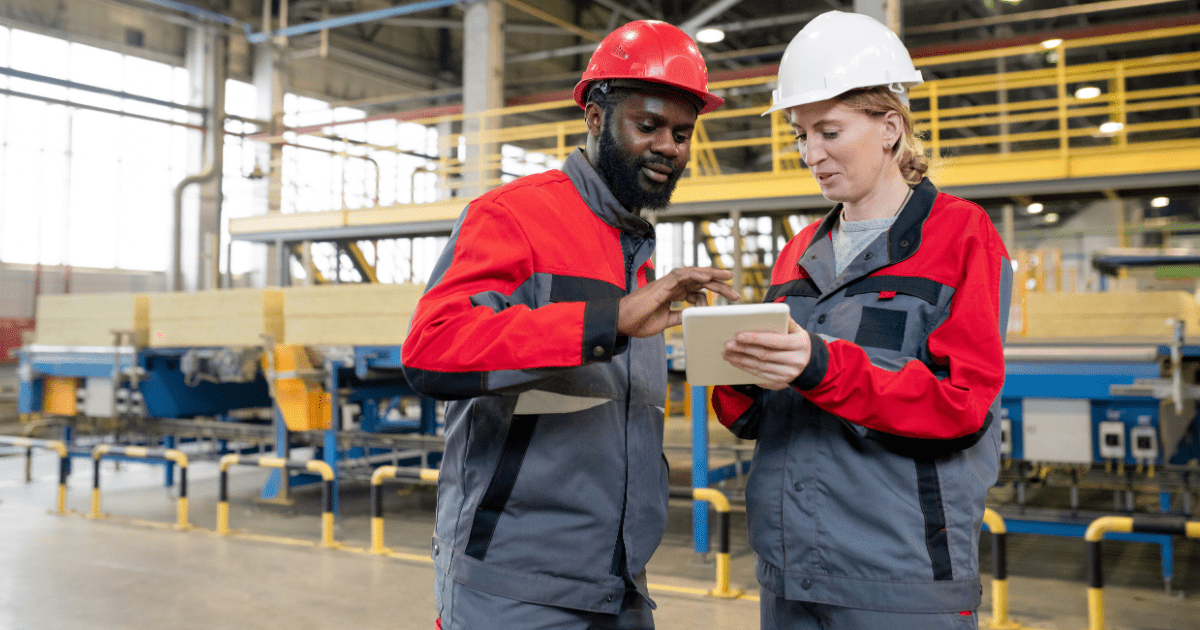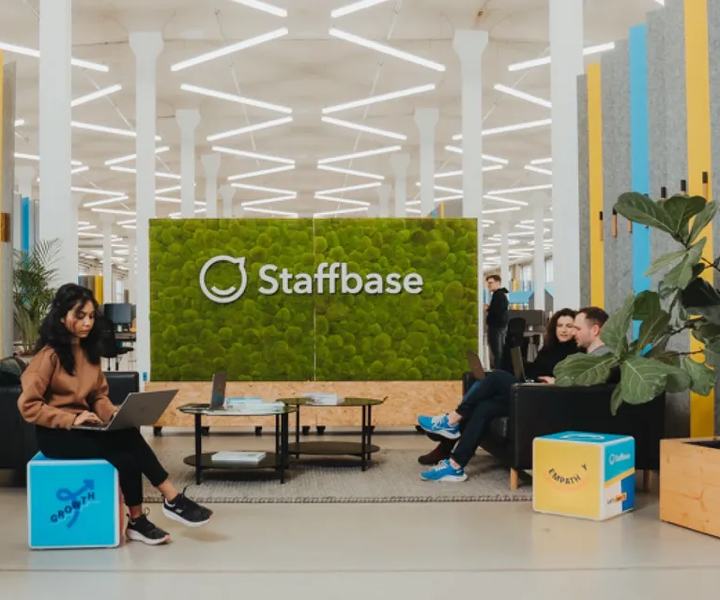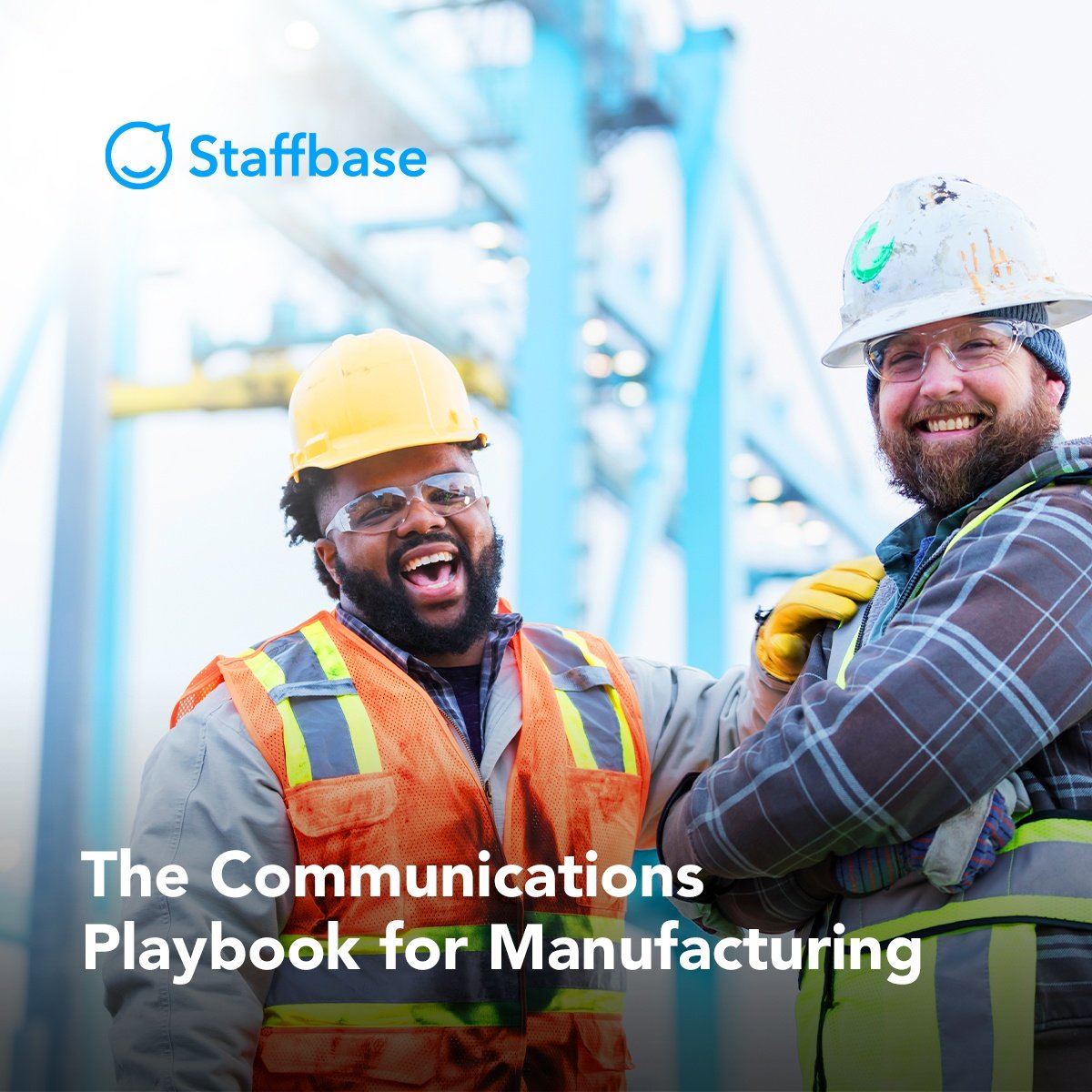How to Build Employee Engagement in the Manufacturing Industry
Practical strategies and real-world examples to help manufacturing leaders engage, connect, and retain their workforce.

Why employee engagement matters in manufacturing
In manufacturing, employee engagement isn’t just a nice-to-have — it’s a critical driver of productivity, retention, and overall business success. Yet many manufacturing organizations face a significant barrier: disconnection. Poor communication leaves employees feeling unheard, undervalued, and disengaged, which directly impacts turnover rates and operational efficiency. When workers aren’t aligned with the company’s goals, they can’t perform at their best or contribute to a thriving workplace culture.
Engaged employees, on the other hand, are more than just productive — they are advocates for your brand. When workers feel informed, connected, and valued, they are more likely to embrace the company’s mission, take pride in their roles, and contribute meaningfully to organizational success. In a fast-changing industry like manufacturing, fostering this sense of engagement isn’t optional; it’s essential for staying competitive.
The key to turning disengaged workers into brand advocates is communication. Clear, consistent messaging helps align employees with the company’s vision, builds trust, and ensures everyone — from the production line to the C-suite — feels like a vital part of the team. By focusing on improving communication, manufacturers can unlock the full potential of their workforce and create a culture where employees are inspired to contribute to the bigger picture.
Unique challenges of employee engagement in manufacturing
Employee engagement is an ongoing challenge for many industries, but manufacturing faces unique barriers that can hinder connection, alignment, and trust within the workforce. These challenges often stem from the complexity of the manufacturing environment, where frontline workers make up the majority of employees but are often the hardest to reach.
1. Limited digital access for frontline workers
Unlike office-based employees, many frontline workers lack access to the digital tools and platforms that facilitate seamless communication. Without mobile-friendly solutions or personalized updates, important messages often fail to reach the people who need them most — leaving workers feeling disconnected and undervalued.
2. Language and cultural barriers
Manufacturing teams often span multiple countries, cultures, and languages. While this diversity is a strength, it also creates a communication gap. Without translations or content designed to resonate across cultures, key updates can be misunderstood or ignored, further contributing to disengagement.
3. Shift work and siloed communication channels
The 24/7 nature of manufacturing means employees work on rotating shifts, making it difficult to deliver messages consistently. Traditional methods like bulletin boards or manager cascades struggle to keep pace with real-time updates, leaving many workers out of the loop and reducing overall engagement.
4. Low participation in employee surveys
While employee surveys are a staple for gauging engagement, they often fall flat in manufacturing. Low participation rates — caused by lack of access, skepticism about impact, or unclear processes — mean leaders are left without meaningful data to inform improvements.
These challenges highlight gaps in tools and processes that make it harder to engage employees effectively. However, they also point to an opportunity: by addressing these barriers with modern, inclusive communication strategies, manufacturers can create a work environment where every employee feels informed, connected, and empowered to contribute. Solving these issues isn’t just a step forward — it’s a game-changer for workforce engagement and business success.
How to improve employee engagement in manufacturing
Improving employee engagement in manufacturing starts with addressing one of the industry’s most persistent challenges: communication. By modernizing how information flows, fostering leadership visibility, and creating opportunities for two-way interaction, manufacturers can build stronger connections with their workforce and boost engagement at every level.
1. Modernize communication channels
Traditional communication methods like bulletin boards or word-of-mouth cascades often fail to reach today’s manufacturing workforce, especially frontline workers who operate away from desks. Modern, mobile-first tools bridge this gap by delivering real-time updates directly to employees’ devices, ensuring critical information — like safety protocols or shift changes — is always accessible. For example, tools like Staffbase’s employee app provide a centralized hub for updates, messages, and resources tailored to every worker’s needs.
2. Promote leadership visibility
Workers are more likely to trust and feel connected to their organization when they see and hear from its leaders. Regular town halls with inspirational messages from the CEO, live Q&A sessions, or short video updates from executives help employees stay informed and aligned with the company’s mission and goals. Staffbase’s platform simplifies this process by enabling leaders to communicate directly with employees, ensuring their presence is visible across all levels of the organization.
3. Enable two-way communication
Engagement is a two-way street. Employees want to feel heard and know their feedback matters. Using employee apps or surveys to create easy, accessible feedback loops empowers workers to share their insights, concerns, and ideas. Real-time pulse surveys or comment features also allow managers to address issues quickly, demonstrating that the organization values its workforce’s input.
Staffbase’s tools excel in enabling this kind of interaction, offering features like anonymous feedback, sentiment analysis, and live polls to give employees a voice while providing leaders with actionable insights.
By embracing modern tools, fostering transparent leadership, and empowering employees to share their voices, manufacturers can transform disengagement into enthusiasm and alignment. These strategies don’t just improve communication — they lay the foundation for a connected, motivated workforce ready to drive success.
10 proven employee engagement ideas for the manufacturing industry
Engaging employees in the manufacturing industry requires targeted strategies that resonate with a diverse, often deskless workforce. From fostering morale to improving communication, these proven employee engagement ideas can help you build a more connected, motivated team.

1. Peer recognition programs
Create a culture of appreciation by implementing peer-to-peer recognition initiatives. Workers can celebrate each other’s achievements, fostering camaraderie and boosting morale. Digital tools, like Staffbase’s recognition feature, make it easy to create employee spotlight messages in real time.
2. Tailored onboarding workflows
First impressions matter, especially in manufacturing. Automate onboarding workflows that provide new employees with step-by-step guidance, resources, and culture-building messages during their first 90 days. Staffbase’s app can deliver these workflows directly to their mobile devices, ensuring no one is left behind.
3. Digital signage for safety updates
Replace outdated bulletin boards with digital signage to share instant updates about safety protocols, shift changes, or company news. This ensures all employees — no matter where they work — have access to critical information.
4. Feedback loops with pulse surveys
Empower employees to share their voices with regular pulse surveys or app-based feedback tools. This approach not only improves engagement but also provides leaders with actionable insights to address concerns or implement new ideas.
5. Recognition through gamification
Introduce gamification elements like leaderboards or rewards for meeting safety goals, attending training sessions, or collaborating effectively. Gamified employee recognition programs can make routine tasks more engaging and exciting.
6. Immediate translation of safety protocols
Language barriers are a common challenge in manufacturing. Use tools that offer instant translation for safety protocols and key updates, ensuring inclusivity and understanding across a multilingual workforce.
7. Automated work anniversary celebrations
Celebrate milestones like work anniversaries automatically through personalized messages, shoutouts on digital signage, or even small rewards. Gestures like work anniversary messages show employees that their contributions are valued.
8. Mobile-first access to resources
Give employees instant access to resources like shift schedules, safety checklists, or training modules through a mobile app. Tools like Staffbase ensure information is always available, even for deskless workers.
9. Town hall meetings for leadership visibility
Host regular town halls where leaders share updates and answer questions directly from employees. Use live streaming or recorded formats for workers unable to attend in person, ensuring everyone stays informed and connected.
10. Ongoing training and development
Offer opportunities for skill-building through workshops, cross-training programs, or mobile-accessible learning modules. When employees see investment in their professional development, they’re more likely to feel engaged and loyal to the organization.
Start small with quick wins
You don’t have to overhaul your engagement strategy overnight. Quick wins like setting up automated onboarding workflows, using digital signage for safety updates, or creating recognition programs can make an immediate impact. With the right tools and a focus on meaningful connection, manufacturing companies can transform engagement into a powerful driver of success.
These ideas are just the beginning — explore how platforms like Staffbase can simplify and enhance your employee engagement efforts.
Trusted employee engagement activities from successful manufacturing companies
Real-world success stories demonstrate the transformative impact of effective communication and engagement strategies. By leveraging modern tools and approaches, these manufacturing companies have boosted employee morale, improved communication, and created stronger connections across their workforce.
1. Seaboard Triumph Foods: Showcasing support programs
Seaboard Triumph Foods recognized the need to do more than just provide paychecks — they wanted to build a culture where employees felt valued and supported. By using Staffbase, they created a centralized platform to promote employee support programs, like wellness initiatives and team recognition efforts. This approach not only highlighted the company’s commitment to its workforce but also fostered a sense of belonging.
Employees have a desire for more than a paycheck, and manufacturing has been behind the curve on this. But at Seaboard Triumph Foods, we are striving to do more for our team members—to appreciate them and support them. Using Staffbase to complement that and showcase our programs has been really beneficial.” — Erin Cantrell, Seaboard Triumph Foods
2. MAN Truck & Bus: Enhancing multilingual communication and connection
As a global company, MAN Truck & Bus faced the challenge of communicating effectively across a multilingual workforce. They implemented Staffbase’s multilingual capabilities to ensure that employees across regions received clear, accessible updates in their native languages. By prioritizing inclusivity and providing localized content, they bridged cultural gaps and strengthened connections between global and local teams.
3. Wieland: Creating a seamless onboarding experience
Wieland understood that the onboarding process is critical for setting the tone with new hires. Using automated onboarding workflows through Staffbase, they delivered timely, step-by-step resources that equipped employees with essential information while embedding the company’s culture from day one. Regular automated messages provided guidance and allowed new hires to offer feedback, fostering immediate engagement and alignment with company goals.
Proven strategies, real results
These examples highlight how manufacturing companies are tackling engagement challenges head-on by embracing modern communication tools and strategies. Whether it’s promoting support programs, connecting multilingual teams, or streamlining onboarding, these organizations demonstrate that meaningful engagement is not only possible — it’s essential for success.
Want to learn how these strategies could work for your company? Explore how Staffbase can help you transform your communication and employee engagement efforts.
How employee engagement software improves connection in manufacturing
In manufacturing, the workforce’s unique structure — dominated by deskless workers and shift-based schedules — creates significant challenges for fostering engagement and connection. Traditional communication methods, like bulletin boards or paper notices, often fail to reach the people who need them most. This is where modern employee engagement software becomes a game-changer.
1. Bridging gaps for deskless workers and shift teams
Manufacturing employees are frequently on the move, working away from desks or shared terminals. Employee engagement software bridges this gap by providing mobile-first solutions that ensure every worker has access to important updates, resources, and recognition programs, regardless of their location or shift. With a tool like Staffbase, communication becomes seamless — reaching employees wherever they are, in real time.
2. Streamlining communication across shifts
Engagement software eliminates the delays and inconsistencies caused by manual communication cascades. Features like push notifications and automated workflows allow leaders to deliver critical updates instantly to employees’ mobile devices. Whether it’s a safety protocol change, shift adjustment, or emergency alert, workers receive the information they need when they need it.
3. Enabling recognition and feedback
Recognition is a powerful driver of engagement, and software solutions make it easier than ever to celebrate employee achievements. From peer recognition tools to gamified rewards, these platforms provide a space for employees to feel valued and connected to their teams. Similarly, built-in feedback mechanisms, like pulse surveys and real-time comment features, create a two-way dialogue that empowers employees and provides leaders with actionable insights.
4. Automating key workflows
From onboarding new hires to delivering targeted training materials, engagement software streamlines processes that are critical to employee success. Automated workflows ensure consistency and efficiency, saving time while reinforcing the company’s commitment to supporting its workforce.
A connected workforce drives success
Employee engagement software doesn’t just simplify communication — it transforms it. By providing tools that reach every worker, streamline information flow, and foster meaningful connections, manufacturers can overcome the barriers of a complex workforce structure. With platforms like Staffbase, manufacturing companies can build a more connected, informed, and engaged workforce ready to meet today’s challenges and drive tomorrow’s success.
How to measure employee engagement in manufacturing
Employee engagement is often described as intangible, but in manufacturing, where precision and metrics define success, measuring engagement is both possible and essential. Tracking engagement provides manufacturers with the insights needed to improve workforce satisfaction, reduce turnover, and boost productivity. The key lies in focusing on outcome-based metrics that show real impact, rather than surface-level outputs.
1. Focus on outcome-based metrics
Measuring employee engagement starts with identifying the right metrics—those that tie engagement to business outcomes. In manufacturing, these often include:
Retention Rates: Engaged workers are more likely to stay, reducing costly turnover.
Sentiment Scores: Understanding how employees feel about their roles and the workplace helps leaders address issues before they escalate.
Acknowledgment Rates: Tracking how many employees read and act on key updates ensures critical information is reaching the people who need it most.
These metrics provide a clear picture of engagement levels and how they influence broader organizational goals, like safety compliance, productivity, and workforce morale.
2. Use tools designed for real-time insights
Modern engagement tools make it easier than ever to measure and act on employee feedback. For example, Staffbase’s platform offers features like:
Pulse Surveys: Quick, focused surveys help gauge employee sentiment and gather actionable feedback in real time.
Analytics Dashboards: Centralized dashboards allow leaders to monitor engagement metrics, like acknowledgment rates and survey participation, all in one place.
Sentiment Analysis: Built-in tools analyze employee responses, providing deeper insights into workforce morale and alignment with company goals.
These features ensure that data isn’t just collected — it’s actionable, helping leaders make informed decisions and course-correct when necessary.
3. Link engagement to business outcomes
Engagement metrics shouldn’t exist in isolation; they should be tied directly to organizational objectives. For example:
Improving acknowledgment rates for safety protocols can reduce workplace incidents.
Increasing employee retention rates saves costs associated with recruiting and training new hires.
Higher sentiment scores contribute to a more motivated, productive workforce.
By connecting engagement efforts to measurable outcomes, manufacturers can clearly demonstrate the value of their initiatives and justify further investment in employee experience.
Measure what matters to build a better workplace
Measuring employee engagement in manufacturing isn’t about ticking boxes — it’s about gaining actionable insights that lead to real improvements. With the right tools, like Staffbase’s pulse surveys and intranet analytics dashboards, manufacturers can track what matters most, make data-driven decisions, and continuously improve the employee experience. The result? A connected, engaged workforce that drives business success from the factory floor to the boardroom.
Conclusion: Building a connected and engaged workforce
Employee engagement in manufacturing isn’t just a strategy — it’s a foundation for success. By addressing communication challenges, modernizing tools, and creating meaningful connections across your workforce, you can transform disengagement into productivity, trust, and alignment with your company’s goals.
Thoughtful communication is the key to unlocking this potential. Whether it’s providing real-time updates, amplifying employee voices, or fostering leadership visibility, each step brings you closer to a workforce that feels valued, connected, and motivated to drive success.
Staffbase offers the tools and expertise to make this vision a reality. From mobile-first apps to pulse surveys and recognition programs, our platform empowers manufacturers to create an engaged workforce that thrives in today’s fast-paced, complex environment.
Now is the time to invest in your people and build a workplace where every employee feels connected to your mission. With the right tools and strategies, you can create a culture of engagement that drives long-term success in the manufacturing industry.










